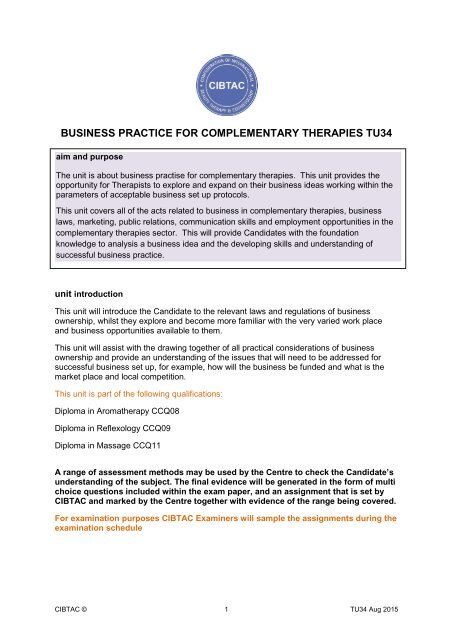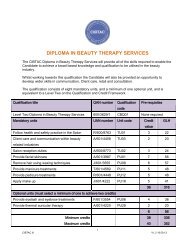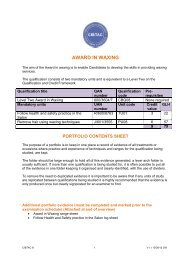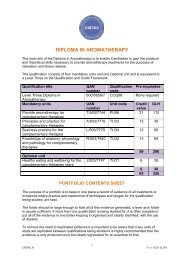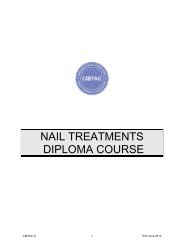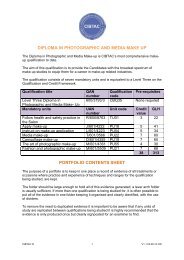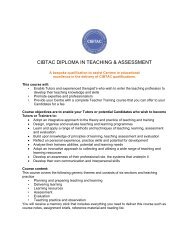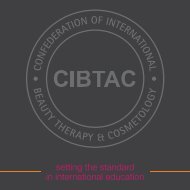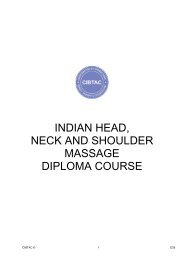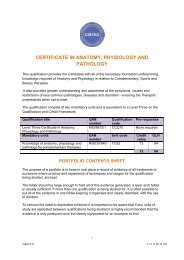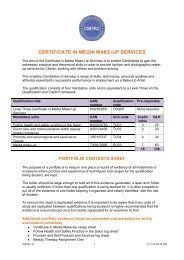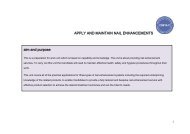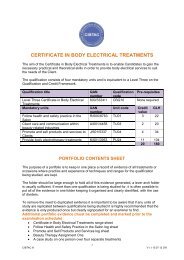BUSINESS PRACTICE FOR COMPLEMENTARY THERAPIES TU34
BUSINESS PRACTICE FOR COMPLEMENTARY THERAPIES TU34
BUSINESS PRACTICE FOR COMPLEMENTARY THERAPIES TU34
You also want an ePaper? Increase the reach of your titles
YUMPU automatically turns print PDFs into web optimized ePapers that Google loves.
<strong>BUSINESS</strong> <strong>PRACTICE</strong> <strong>FOR</strong> <strong>COMPLEMENTARY</strong> <strong>THERAPIES</strong> <strong>TU34</strong>aim and purposeThe unit is about business practise for complementary therapies. This unit provides theopportunity for Therapists to explore and expand on their business ideas working within theparameters of acceptable business set up protocols.This unit covers all of the acts related to business in complementary therapies, businesslaws, marketing, public relations, communication skills and employment opportunities in thecomplementary therapies sector. This will provide Candidates with the foundationknowledge to analysis a business idea and the developing skills and understanding ofsuccessful business practice.unit introductionThis unit will introduce the Candidate to the relevant laws and regulations of businessownership, whilst they explore and become more familiar with the very varied work placeand business opportunities available to them.This unit will assist with the drawing together of all practical considerations of businessownership and provide an understanding of the issues that will need to be addressed forsuccessful business set up, for example, how will the business be funded and what is themarket place and local competition.This unit is part of the following qualifications:Diploma in Aromatherapy CCQ08Diploma in Reflexology CCQ09Diploma in Massage CCQ11A range of assessment methods may be used by the Centre to check the Candidate’sunderstanding of the subject. The final evidence will be generated in the form of multichoice questions included within the exam paper, and an assignment that is set byCIBTAC and marked by the Centre together with evidence of the range being covered.For examination purposes CIBTAC Examiners will sample the assignments during theexamination scheduleCIBTAC © 1 <strong>TU34</strong> Aug 2015
Portfolios to include supplementary evidence of the followingAn assignment based on the business practices for complementary therapies -Complementary therapy assignment two. This assignment is attached to the end of thissyllabus.Through exploring all of the considerations of business set up it is expected the Candidatewill be able to review their personal strengths and identify any additional training orprofessional development requirements for the venture to be successful.Business practice for complementary therapies taught content to includeLearning outcomes 1The learner will: Understand the key business criteria required for complementarytherapyAssessment criteriaThe learner can:1.1 Explain the legal requirements for running a business1.2 Explain how marketing and public relations are used in businesses1.3 Describe the employment opportunities within the complementary therapy industry1.4 Explain how to promote complementary therapy practicesSummarise each of the following acts and their relevance to operating acomplementary practice or clinic to includeThe Environmental Protection Act 1990 • The Work Place Regulations (Health, Safety andWelfare) 1992 • Health and Safety at Work Act 1974 • The Management of Health andSafety at Work Regulations 1999 • The Health and Safety (First Aid) Regulations 1981 •Dangerous Substances and Preparations (nickel) (safety) Regulations 2005 • The PersonalProtective Equipment at Work Regulations 1992 •The Provision and Use of Work EquipmentRegulations 1998 • The Control of Substances Hazardous to Health Regulations (COSHH)2002 • Reporting of Injuries, Diseases and Dangerous Occurrences Regulations (RIDDOR)1995 • The Electricity at Work Regulations 1989 • The Fire Precautions Act 1971 • The FirePrecautions (Workplace) Regulations 1997 • The Manual Handling Operations Regulations1992 • Employers Liability Act 1969 • Working Time Regulations 1998 • General ProductsSafety Regulations 2005 • Cosmetic Products (Safety) Regulations 2008 • The Supply ofGoods and Services Act 1982 • The Sale and Supply of Goods Act 1994 • The ConsumerProtection Act 1987 • Trades Description Act 1972 • Local Government (MiscellaneousProvisions) Act 1982 • Data Protection Act 1998 Social Services Act 1970 • The Equality Act2010 • Mental Health Act 2007 • ECHR (Human Rights Act) 1998 • The Care Standards Act2000 • Medical Act 1983 • Children Act 1989 • Sex Offenders Act 1997 • Crime and DisorderAct 1998 • Protection of Children Act 1999 • Youth Justice and Criminal Evidence Act 1999 •The Children (leaving care) Act 2000 • Copyright, Designs and Patents Act 1988 (PerformingRights) • VAT Act 1994 • Veterinary Surgeons Act 1966 • Medicines and Healthcareproducts Regulatory Agency (MHRA) requirements • Prohibited appellation regulationsCIBTAC © 2 <strong>TU34</strong> Aug 2015
Explain the licensing laws involved with establishing a business to includeLocal and national bye laws • Who to contact for information • Treatments which may requirelicensing e.g. Massage and special treatments (MST) licence • Exemptions from licensingExplain the main forms of marketing and public relations and their roles in businesssuccess to includeIdentify potential market and customers • Products and services • Newspapers • Pressreleases • Leaflets • Direct mail • Word of mouth • Television • Internet • Cinema • Radio •Posters • Talks • Demonstrations • Exhibitions • Open days • Charity events • SponsorshipClarify key employment opportunities within the complementary therapy industries,outlining roles, responsibilities and progression routes, for exampleEmployed • Self-employed • Receptionist • Junior Therapist • Therapist • Senior Therapist •Clinic or spa manager • Director • Health care sector • Spas • Clinics • Salons • VoluntarysectorExplain methods of effective communication and the importance in a successfulbusiness to includeMethods of communication e.g. verbal, non-verbal • The importance of maintaining goodworking relationships • Good communication skills (asking open and closed questions whereappropriate, listening or hearing) • Barriers to effective communication • Demonstrateappropriate body language at all times • Interpersonal distance • Trust • Professionalism,confidence and enthusiasm • Confidentiality • Personal effectiveness • With other Therapists• As part of team • With Clients • With suppliersIdentify the methods of promotion suitable for complementary therapy practices toincludeSampling • Point of sale displays • Merchandising • Loyalty cards • Price reductions •Competitions • After sales service • Bonus retail product packs • Treatment programmeschemesClarify the importance of corporate image for the design and production of thefollowingBusiness card • Price List • Stationery • Poster • Consultation forms • Client aftercare adviceformsCIBTAC © 3 <strong>TU34</strong> Aug 2015
Learning outcomes 2The learner will: Be able to research a business conceptPractical assessment criteriaThe learner can:2.1 Compare and contrast different business types2.2 Research a potential business opportunity using a range of resources2.3 Research potential premises, staff, products and resource requirementsCritically compare the types of business and the advantages and disadvantages ofeach to includeSole trader • Partnership • Limited company • Limited liability partnership • FranchiseDevelop a business idea, using research material from a variety of sources to includeThe internet • Newspapers • Magazines • Directories • Advertising • Word of mouthDistinguish a business opportunity to includeBusiness location • Type of premises • Rent space • Rent premises • Leasehold • Freehold •Business type (as listed previously) • Décor • Heating • Lighting • Ventilation • Plumbing •Flooring • Interior décor • General furnishings • Layout • Waste disposal • Laundry • Storage• Reception • Treatment areas • Relevant equipment and couchesStaffing requirementsJob description • Curriculum Vitae (CV) • Contract of employment • Hours of work • Salaryand any commission structure • Holiday entitlement • Period of notice for either party •Disciplinary procedure • Maternity leave • Grievance policyProductsConsumables • Professional products • Retail products • Stock control • Stock rotationServicesWhat services to be offered • What is the local competition • What skills currently possess •What skills to be learntBudgetWhat is the overall budget • Where and how do you prioritise spendingCIBTAC © 4 <strong>TU34</strong> Aug 2015
Learning outcomes 3The learner will: Be able to plan and prepare a business planPractical assessment criteriaThe learner can:3.1 Prepare an appropriate business plan for self-employment3.2 Describe the professional services, staff and resources that may be required for abusiness planPlan, prepare and maintain a business plan to includeMission statement • Market research • Competitor analysis • Premises and location •Products, services and prices • Fixed and variable costs • Staffing requirements – jobdescriptions • CVs • SWOT analysis • Risk analysis • Insurance • Marketing and publicity •Finance and accounting practices • Cash flow forecast • Security and data protectionAssess business plan findings and incorporate potential additional costs to includeBuilders • Decorators • Plumbers • Solicitors • Electricians • Accountants • Printers •Products • Suppliers • Marketing and PR • Administration and IT • Professional recruitmentExplain how to cost a treatment or service to includeOverheads • Commercially acceptable treatment times • Product costs • Consumable costs •Staffing costs • Retail product costs • ProfitExplain the benefits of offering courses of treatment to includeEnsure that Clients return to the Salon or Clinic • Ensure that cash is paid in advance •Improve cash flow • Treatment programme discountsExplain the importance of developing and maintaining a good stock control system toincludeRegular stock checks • Regular stock valuation • Regular rotation of stock i.e. ensure thenewest products are stored at the back and oldest drawn forward • Regular ordering • Orderproducts quickly and do not stand on the shelvesDefineAccounts • Assets • Allowable expenses • Basic profit and loss • Budget • Car expenses •Cash flow • Corporation tax • Costing of treatments ▪ Drawings • Expenditure • Fixedoverheads • Gross profit • Income • Income tax • Petty cash • Personal pensions • Personaltax • Salary • Self assessment tax • Spreadsheets • Tax returns • Value Added Tax (VAT) •Variable overheads • Methods of record keeping • National Insurance contributions (NIC) •Net profitHow to review research material and calculate start up and running costsCIBTAC © 5 <strong>TU34</strong> Aug 2015
<strong>COMPLEMENTARY</strong> <strong>THERAPIES</strong> –ASSIGNMENT TWOunit <strong>TU34</strong> business practice for complementary therapiesPlan and prepare an appropriate business plan for a potential complementary therapypractice to include• Mission statement• Market research• Competitor analysis• Premises and location• Corporate image and design e.g. marketing and publicity material, businessstationery• Products, services and prices• Fixed and variable costs• Staffing requirements and employment opportunities• SWOT analysis• Risk analysis• Marketing and publicity• Finance e.g. start up, running costs• Additional professional services• Legal requirements• Security and data protection• Customer service and communicationAnalysis of findings should be presented in a written reportA selection of the completed and marked assignments will be sampled by the CIBTACExaminer during the CIBTAC examination scheduleCIBTAC © 6 <strong>TU34</strong> Aug 2015
CIBTAC ASSIGNMENT FEEDBACK SHEETAssignment name and identification number……………………………………………………Tutor comments and feedbackCandidate presented sufficient evidence covering all of the given criteriaCandidate is directed to provide additional evidenceYes/NoYes/NoDate for resubmissionDate for resubmission metGiven ……………….Yes/NoTutor name………………………….. Tutor signatue…………………………………….CIBTAC © 7 <strong>TU34</strong> Aug 2015
<strong>COMPLEMENTARY</strong> <strong>THERAPIES</strong> - ASSIGNMENT TWOMARKING GUIDANCEunit <strong>TU34</strong> business practice for complementary therapiesTutors/assessors should use this form to evaluate the candidate’s submittedevidence. How the evidence is structured is at the discretion of the tutor and can bea combination of written, diagrammatical or another form of visual presentationincluding oral questioning and group discussion.Oral questioning and group discussion should not amount to more than 20% of theoverall evidence submitted and will need to be completed in the presence of a tutorwho is required to initial the witness column on the table below on behalf of thecandidate.Please indicate in the table below with a √ which source of information wassuccessfully submitted, and indicate with an X evidence submitted but notsuccessfully. Learners may re-submit evidence for further evaluation at any stage of theircourse if a pass is not initially achieved. All assignments must be successfullycompleted and marked by the tutor prior to the commencement of the relevantexam schedule the candidate is entered into When all evidence has been submitted and accepted assessors must place a √ inthe Assignment Completed box. This indicates a pass mark All of the assignments listed in the qualification overview along with the formaltutor feedback must be available for sampling by the examiner for all of thecandidates entered into the exam at the beginning of the exam schedule. A formal CIBTAC feedback sheet is available to download for use if the schooldoes not have their own versionCIBTAC © 8 <strong>TU34</strong> Aug 2015
Assignment <strong>TU34</strong> Business Practice for Complementary Therapies mark sheetCandidates name ……………………………………………… Candidatesnumber……………..………Evidence that the candidateconsidered the followingWrittenwordDiagrammaticalevidenceProfessionaldiscussion/oralquestioningTutorinitialsDateacceptedMission statementMarket researchCompetitor analysisPremises/locationCorporate image and design –business stationery, marketing andpublicity materialProducts, services and pricesFixed and variable costsStaffing requirements andemployment opportunitiesSWOT analysisRisk analysisMarketing and publicityFinance – start up and runningcostsAdditional professional servicesLegal requirementsSecurity and data protectionCustomer service andcommunicationCompletedDate the assignment was completedY N Tutor name and signatureSampled by CIBTAC examinerName…………………………….Date………………………………CIBTAC © 9 <strong>TU34</strong> Aug 2015


